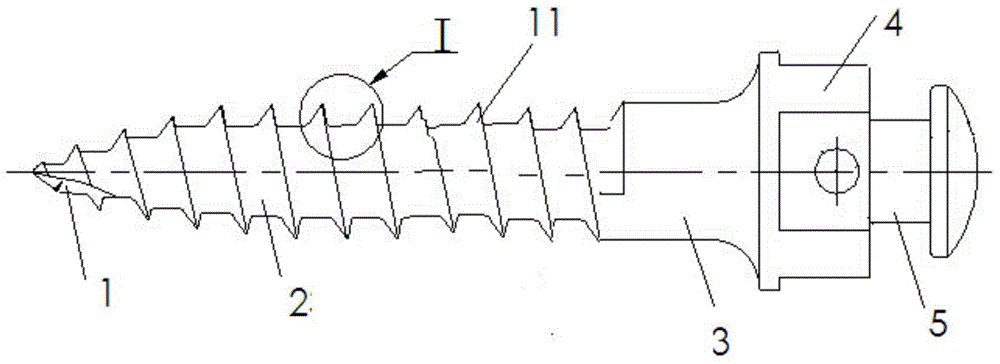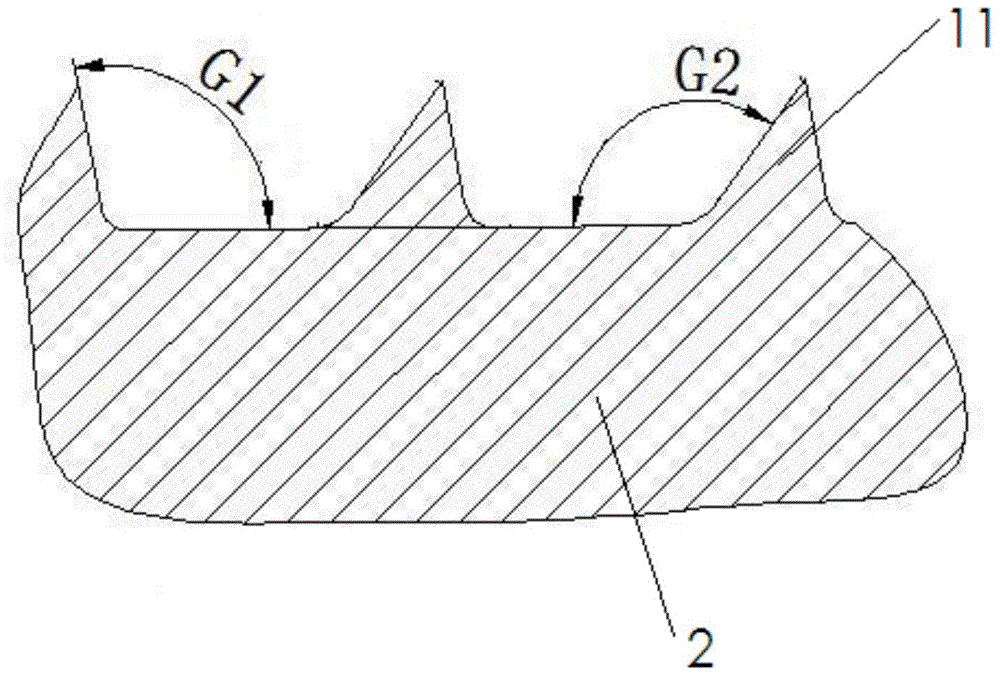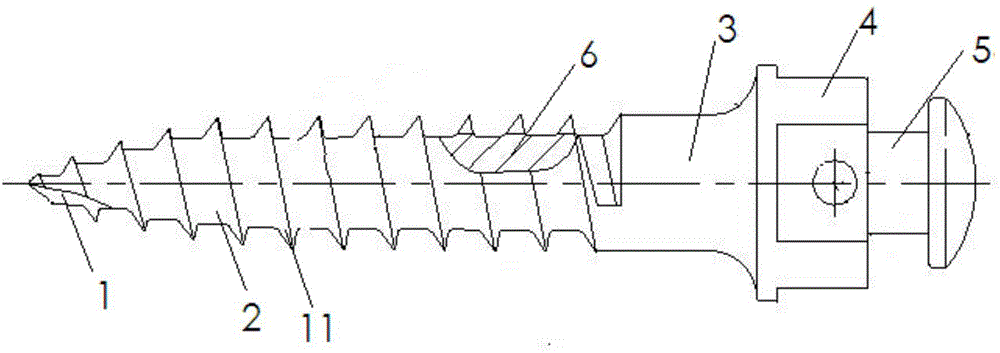Miniature anchorage screw and correcting device with same
An anchorage nail and a miniature technology are applied in the field of miniature anchorage nails and orthodontic devices containing the mini anchorage nails, and can solve the problems of circumferential displacement of anchorage nails, poor release of traction force, and reduced effectiveness of orthodontic correction, etc. Achieve the effect of improving circumferential stability and avoiding bad release
- Summary
- Abstract
- Description
- Claims
- Application Information
AI Technical Summary
Problems solved by technology
Method used
Image
Examples
Embodiment 2
[0049] The second embodiment is: the circumferential stabilizing grooves 6 are arranged on the tooth forms 8 , 9 , 10 and 11 .
[0050] Certainly, the number of tooth-shaped bodies 11 that screw body 2 is provided with from the top to the tail end is not unique, and can be adjusted as required. Similarly, the position of circumferential stabilizing groove 6 can also be adjusted according to the length of screw body 2, but Always at the tail end of the screw body 2.
[0051] Example 1: The screw main body 2 is provided with 10 conodonts 11 from the top end to the tail end, named respectively as conodonts 1, 2, 3, 4, 5, 6 and 7. , Conodont 8, Conodont 9, and Conodont 10. For the first embodiment, the circumferential stabilizing groove 6 is arranged on the tooth form 8, the tooth form 9 and the tooth form 10;
[0052] Example 2: The screw main body 2 is provided with 12 conodonts 11 from the top end to the tail end, named respectively as conodonts 1, 2, 3, 4, 5, 6 and 7. , Con...
Embodiment 1
[0066] If the first cavity wall 7 actually has the number of effective thread teeth N=3,
[0067] Then the average small first cavity wall 7 on each conodont 11 bears a force f N =F N / 3=180 / 3=60 grams.
[0068] Assume that the helix angle ∠W=68.04° in this embodiment (according to the M2.0 anchor screw, here is not measured by the diameter of the pitch circle for the time being)
[0069] Then the small first cavity wall 7 on each conodont 11 is stressed:
[0070] f P = f N *SIN∠W=60*SIN68.04=55.65 grams
[0071] f S = f N *COS∠W=60*COS68.04=22.44 grams
[0072] shear stress f N The component forces on the first cavity wall 7 and in the normal direction perpendicular to the first cavity wall 7 are respectively f P and f S , in other words, f P The small first cavity wall 7 on each conodont 11 supports the effective shearing force on the compact bone when the nail is subjected to the maximum torque.
[0073] set f w is the shear strength of the implanted part of t...
Embodiment 2
[0076] If the actual effective thread thread number N=4 of the first chamber wall 7,
[0077] Then the average small first cavity wall 7 on each conodont 11 bears a force f N =F N / 4=180 / 4=45 grams.
[0078] Assume that the helix angle ∠W=68.04° in this embodiment (according to the M2.0 anchor screw, here is not measured by the diameter of the pitch circle for the time being)
[0079] Then the small first cavity wall 7 on each conodont 11 is stressed:
[0080] f P =f N *SIN∠W=45*SIN68.04=41.74 grams
[0081] f S =f N *COS∠W=45*COS68.04=16.82 grams
[0082] shear stress f N The component forces on the first cavity wall 7 and in the normal direction perpendicular to the first cavity wall 7 are respectively f P and f S , in other words, f P The small first cavity wall 7 on each conodont 11 supports the effective shearing force on the compact bone when the nail is subjected to the maximum torque.
[0083] set f w is the shear strength of the implanted part of the com...
PUM
| Property | Measurement | Unit |
|---|---|---|
| Helix angle | aaaaa | aaaaa |
Abstract
Description
Claims
Application Information
 Login to View More
Login to View More - R&D
- Intellectual Property
- Life Sciences
- Materials
- Tech Scout
- Unparalleled Data Quality
- Higher Quality Content
- 60% Fewer Hallucinations
Browse by: Latest US Patents, China's latest patents, Technical Efficacy Thesaurus, Application Domain, Technology Topic, Popular Technical Reports.
© 2025 PatSnap. All rights reserved.Legal|Privacy policy|Modern Slavery Act Transparency Statement|Sitemap|About US| Contact US: help@patsnap.com



